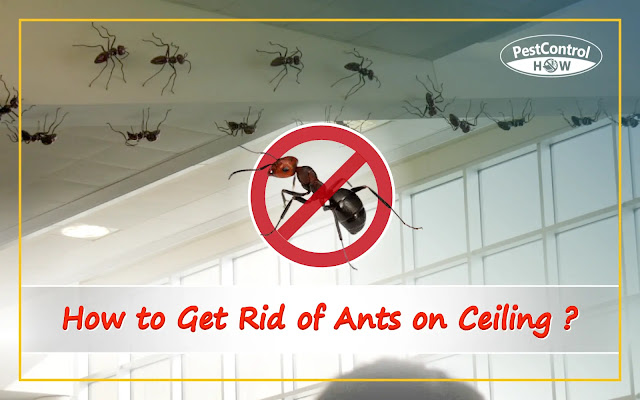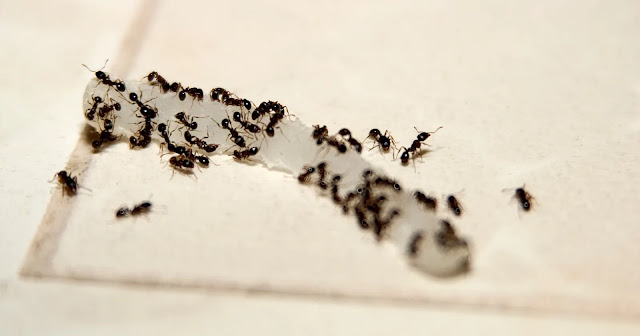Most homeowners find the sight of ants scurrying around their homes very distasteful. The situation is even worse when ants decide to take refuge in your ceiling. Several ant species are adapted for climbing vertically in their natural habitats. For instance, carpenter ants have grippy hairs, suction pads, and claws on their feet, allowing them to climb walls and ceilings.
Dealing with ants on ceiling is not an unusual phenomenon. In fact, pest control experts are often called to get rid of ants that have taken permanent residence in ceilings. Ants don't eat wood like termites. But they can severely affect the structural integrity of your ceiling by making tunnels through the wood to create nests.
Here is the complete practical guide on how to get rid of ants on the ceiling.
{tocify} $title={Table of Contents}
Which Ant Species Climb Walls and Ceilings?
Several ant species are adept at climbing most solid surfaces and nesting in walls and ceilings. Being able to correctly identify these species will help you apply an effective control strategy and prevent possible damage. Here are the ant species notorious for hiding in your ceiling:
Carpenter Ants
Carpenter ants are beneficial when in their natural environment. They convert living and dead wood into dust that biodegrades and enriches the soil. However, they can be extremely destructive when they infest your house! They live in large colonies and have powerful jaws that chew/gnaw on damp wood, making large tunnels to nest. Carpenter ants have a reddish-brown or black body, ranging from 3.4 to 13mm in length.
Acrobat Ants
Acrobat ants like to live in rooting wood, especially wood softened by high moisture, fungal decay, or wood-boring insects. They are named after their unique ability to raise their heart-shaped abdomen over their thorax and head. Their color varies from light brown to black, and they are about 3mm long.
Little Black Ants
Little black ants are extremely common in wooded areas like yards, rotting logs, and under piles of lumber. When they infest your home, little black ants prefer to make their nests in woodwork, including behind facades, walls, doors, and window frames. As their name suggests, they are pretty small, roughly 1.55mm long, with a black color and two segmented waists.
Moisture Ants
Moisture ants such as cornfield and citronella are typically attracted to places with high moisture. These wood-destroying critters prefer to build their nests in wet rather than dry wood. They can easily be identified by their yellow or brownish color, and they are usually 4.55mm in length.
How Do You Know If You Have Ants in Ceiling?
Ants don't have a cryptic or secretive lifestyle as bed bugs do. However, it's common for homeowners to miss the signs of ants on ceiling. Luckily, these pesky pests often leave behind a few telltale signs to alert you of a possible infestation.
Here are signs that you may be having ants on ceiling:
- Ants: As mentioned above, ants do not feed on wood. Hence, high chances are that you will see foraging or worker ants as they leave their nests in search of food for the rest of the colony members. If you spot a trail of ants climbing up your wall, that's a sign of an infestation.
- Wood Shavings: Wood shavings will appear underneath beams in your ceiling if carpenter ants have infested. You may also see piles of fine dust, often excavated by pavement ants when making nests.
- Dead Ants: Piles of dead ants are another warning sign that ants have besieged your ceiling.
5 Effective Ways to Prevent Ants On Ceilings
The most effective way to prevent ants on the ceiling is to ensure they do not enter your home in the first place. This means getting rid of all factors that may be attracting the pesky menace into your home:
1. Get Rid of Possible Food Sources
Ants are not picky. They eat just about anything, including aphids, fruits, greasy foods, meats, and living or dead insects. They are especially attracted to sugary foods like the jam residues or drops of honey left on the countertop and sweets discarded in the waste bin.
Ants are social insects. Once they identify a food source, they leave behind a pheromone trail that attracts the rest of the colony to partake in the feast. You want to clean up food crumbs and spills as soon as they occur to keep ants out of your home.
2. Remove Moisture
Ants must have a constant supply of water to survive. Most ant colonies can survive without food for some time but will die if they lack water. That's why most species prefer water-damaged wood. When they find a water source, ants collect the water and take it back to the colony, where it's stored for future use.
Again, ants will leave a pheromone trail to guide other colony members to the water source. You need to fix broken pipes and leaky faucets and avoid overwatering potted plants to keep ants away.
3. Treat Ant Nests
Ants enjoy being warm and cozy. If they get inside your home, they can build nests in walls, ceilings, and baseboards. If you are able to spot an ant nest, you can treat it with mineral-based insecticide dust to kill the ants and destroy their nests.
4. Seal Possible Entry Points
Ants are small enough to enter your home from virtually any gaps, including the tiniest crevices in walls. Inspect your home keenly and take note of small holes in walls and cracks in windows. Seal the cracks, holes, and other gaps with caulk to prevent ants on ceiling.
5. Use Scents That Ants Hate
Ants have an incredibly high sense of smell, which they use to find sweets, candy, and other food sources. You can use this to your advantage by placing plants whose smell ants hate in possible entry points. Examples of such plants are lavender, basil, rosemary, and mint. Besides deterring ants, these plants keep your home smelling fresh.
How to Get Rid of Ants On Ceiling for Good
When getting rid of ants on the ceiling, you must first inspect your home and yard thoroughly. The inspection should help you identify the type of ants you're dealing with, possible entry points, potential food/water sources, and where their nests are located.
Inspecting Your Home for Ants
Even if you successfully get rid of ants on ceiling, they'll keep coming back unless you have eliminated possible entry points and food sources. Here's how to thoroughly inspect your home:
Use a flashlight to look for possible food and water sources in the following areas: Behind and under the refrigerator, dishwasher, oven, inside the pantry, and under the sink. You should also inspect the bathroom and your ceiling for water-damaged wood, high moisture levels, and possible leaks.
While some ant species are active around the clock, most will forage at night. If you spot an ant trail, follow it keenly and try to identify where they are coming in from. You may also be able to follow the ants back to their nests in the ceiling. This will help you know the level of the infestation at hand, which yields more effective ant control results.
If you can't see an ant trail, it may be a good idea to encourage foraging ants by availing a food source. For instance, you can leave a small piece of sweet, a drop of honey, or a small dab of peanut butter in places you've seen ant activity. Within the shortest time, foraging ants will gather to collect the goodies for their siblings.
This test will provide you with two important findings- firstly, you will tell if you're dealing with protein or sugar ants. Accurate identification helps you manage the real cause of the problem. Secondly, you can follow the foraging ants back to their nests.
Employing Counteractive Measures
This involves patching up entry points and removing possible food sources to prevent more ants from entering your home and prevent future infestations.
1. Eliminating Ant Food Sources
These little creepers don’t only infest messy homes. Ants are attracted to food crumbs, sugar granules, spilled liquids, rotting fruits, melted ice creams and more. Therefore, you must improve the sanitation of your home to keep ants away. This involves wiping down food preparation and eating areas, stovetops, countertops, the dripping honey jar, and spills as soon as they occur.
Your efforts to get rid of ants on ceiling will be futile if liquid spills and food cramps constantly attract the little critters. Thoroughly cleaning your house and appliances such as microwave, sandwich maker, juicer, and oven ensures no food or water for ants.
You should also consider using a dehumidifier to remove excess moisture from the air, walls, and ceilings, especially if you live in a high humid climate.
2. Sealing Ants Entry Points
Sealing off ant entry points is one of the fastest and most effective ways to deal with an ant problem. If you identified the possible entry points during the inspection, you should patch those spots with caulking. Sealing the small gaps around cable wires, cracked doors, and broken window seals can keep ants away from your home and deter new infestations.
3. Using Sprays and Baits
Ant-specific sprays are highly effective and kill the little invaders immediately upon contact. Sprays are specialized at killing ants that are out in the open and breaking down the pheromone trail. You should spray the insecticide directly into the ant nest to kill the entire colony and destroy the nests.
There are different forms of ant baits, including liquids, gels, and granules. Ant baits are highly effective and provide a permanent solution to your ant problem. That's because they are designed with an attractant such as sugar, protein, or carbohydrate, and a toxic active ingredient like borax or boric acid. The active ingredient is slow-acting and doesn't kill the foraging ants immediately.
The slow mode of action allows ants enough time to take some of the bait to feed the rest of the colony, including the queen. This way, you effectively exterminate the entire colony and destroy the nests. The likelihood of baits poisoning humans, children, and pets by ingestion is very low. However, you are advised to keep ant baits out of children's and pets' reach.
Final Thoughts
Some ant species have three features that allow them to climb efficiently on walls and ceilings- suction pads, grippy hairs, and claws on their feet. When they infest your home, ants utilize these physical capabilities to walk on just about any surface to reach the moist and water-damaged wood in your ceiling.
Ants don't eat wood in the same way as termites. Instead, they chew on it and excavate tunnels to build their nests. These can significantly impact the structural integrity of your home. As such, you must be proactive about ant control by preventing chances of an infestation. This involves removing possible food and water sources and sealing possible entry points.



